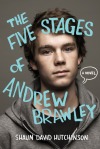Tags
bullying, depression, friendship, graphic novel, grief, homophobiam Elisabeth Kubler-Ross, mental illness teens, Shaun David Hutchinson, suicide, young adult fiction
April Discussion – The Five Stages of Andrew Brawley by Shaun David Hutchinson
The Five Stages of Andrew Brawley by Shaun David Hutchinson was always going to be the type of book that polarises and this was certainly the case with our bookclub. There were some really mixed feelings in the group about this book which made for some interesting discussion. Firstly, let’s discuss the negatives. The biggest issue that its critics had was that this novel simply tried to do too much – some of the members felt that there were too many issues; grief, death, bullying, homophobia, self-harm, attempted suicide and teen cancer and that any of those could have been a novel in itself. It was felt to be very bleak and even though it ended on a positive note some members felt it to be a very grim and dark read, much more than the novel we had read the month before where a character commits suicide.
There was one scene in particular that seemed to bother readers; namely the scene in the ER room where Drew attempted to resuscitate the drowned child. Many of the readers were quite upset by this scene and felt that it was unnecessary to the story, that it detracted from the authenticity of the novel, and that it would be highly unlikely that this could occur in a busy emergency room. We discussed the metaphorical aspects of a scene like that and looked at its purposes for character development but generally most people were uncomfortable with this scene.
We had a long discussion about the target market of a book like this. Many readers could not relate to the graphic component of the novel. We did comment that we had to keep in mind that the teen generation approach texts in different ways from older readers. Some commented that they would skip over the comic strip part of the novel, in an effort to get back to the text, whereas others felt that in doing so the reader misses an essential component of the novel. We agreed it really came down to personal preference whether or not you liked to read graphic novels. Those of us who enjoy reading graphic novels as part of a novel related to the fact that Patient F is used as a device to illustrate Ben’s emotional and mental healing and thought that teens would relate to this element. We also felt that the five stages of grief were most clearly shown through the comic strip.
Now, to discuss the positives about this book. The group felt that there were parts of this novel that were quite beautifully written. It was commented that Drew’s narrative voice at times was quite sarcastic, sardonic and humorous but we are seeing a skewed and filtered view of the world through Drew’s perspective. We had a long discussion about survivor guilt and how Drew’s story fell into Elisabeth Kübler-Ross’s five stages of grief—denial, anger, bargaining, depression, and acceptance. Each person’s experience is different and not every person goes through these stages in any particular order and we noted that some people may experience different stages over and over or never move from one stage to another. We talked about the stages of grief that Rusty, Arnold, Trevor and Lexie deal with as well with their personal issues.
Other topics we discussed were: the developing relationship between Rusty and Drew (although some members thought it was unlikely that Drew would have had such access to an ICU ward), the mystery involving Rusty’s accident, Drew’s struggles with God and religion and his relationship with Father Mike, the role of Michelle the social worker and his relationship with Trevor and Lexie. There was a lot to discuss in this book.
In summary – the comments of the members who did not take to this book were that they really had to suspend disbelief that this story could take place – for some, there was too much going on and the likelihood of all these events happening was beyond belief. For others, the ones who did appreciate the book – the details were not as important as the message. Interestingly, the group members who had read this book quickly and got into the story had a much better reading experience than those who read it over several days. Some have since said that teens in their library have been interested by the blurb and borrowed the book – when we next get together we can see how the feedback from the young adult readers compares.

